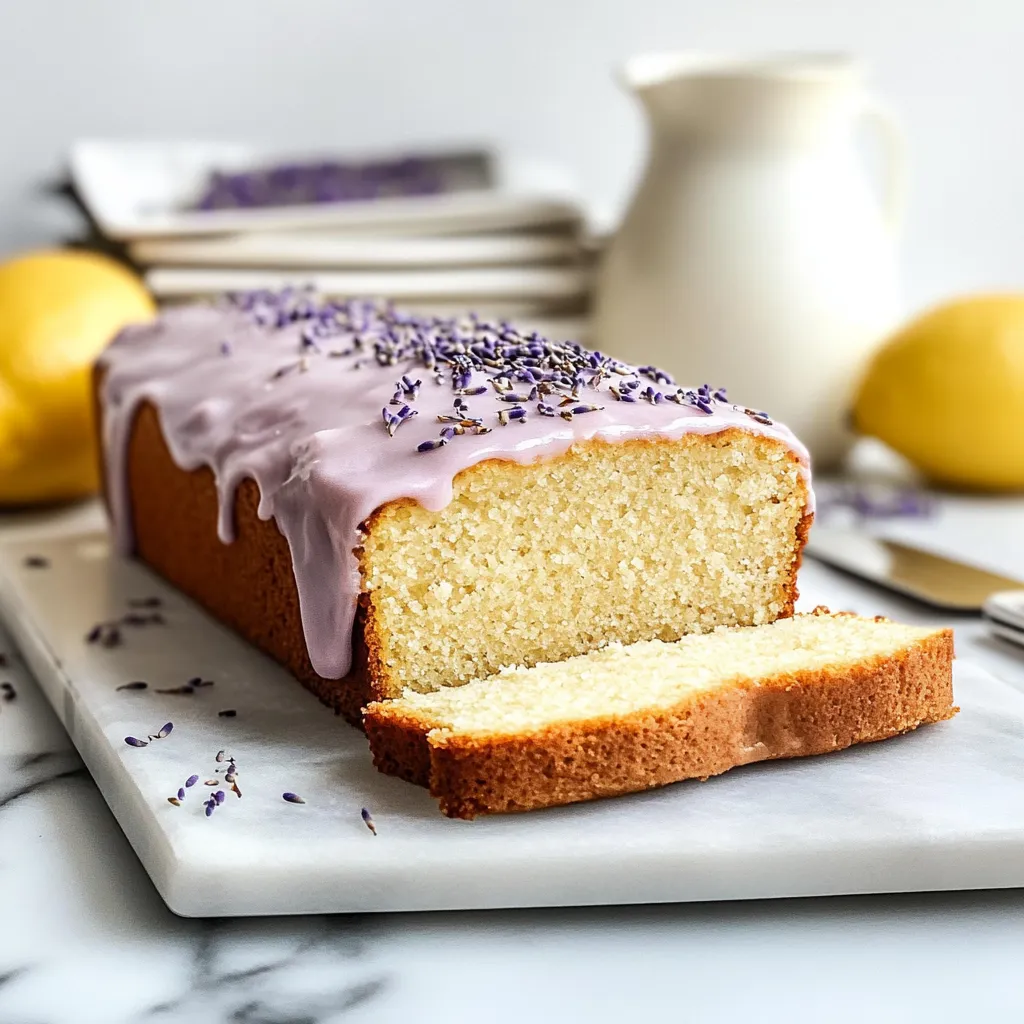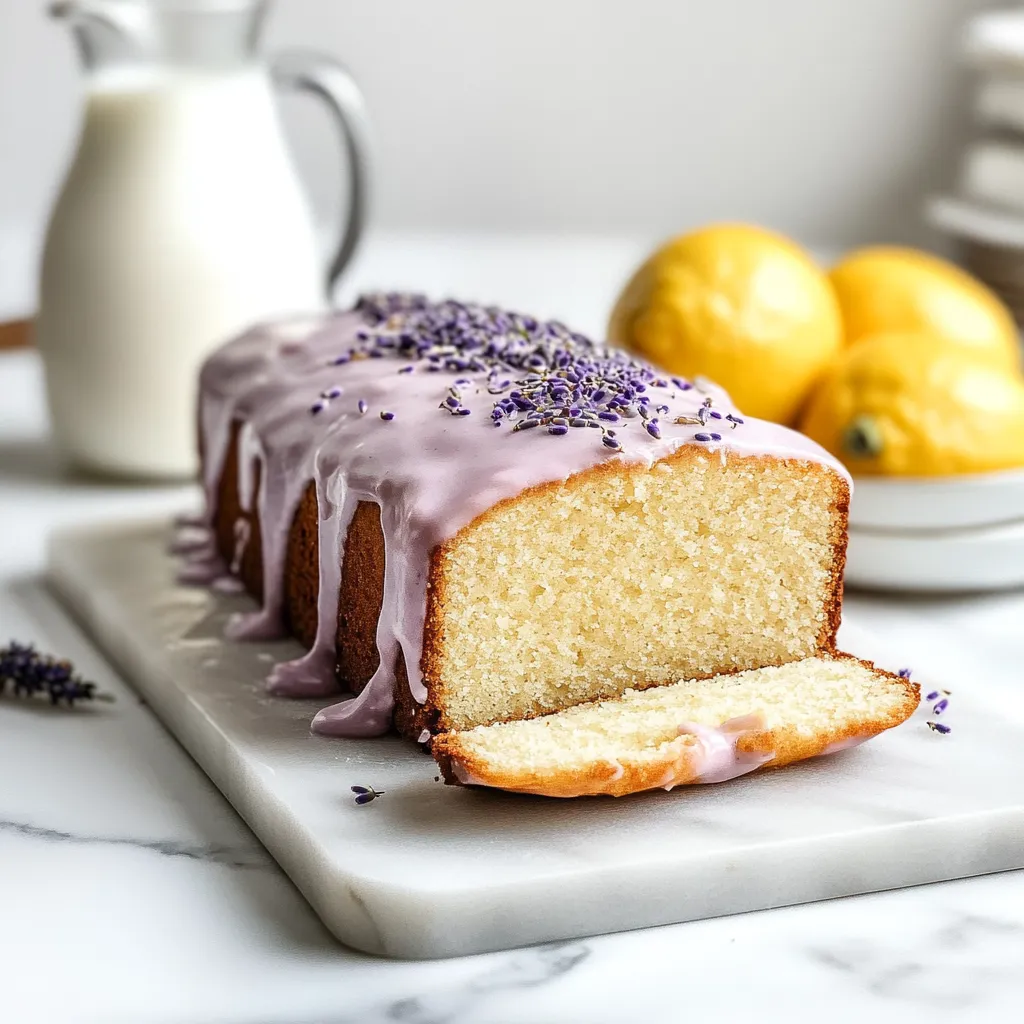 Pin
Pin
Sunshine Citrus Flower Cake brings spring to your table with every bite, mixing zingy lemon highlights with soft floral hints that'll wow your taste buds. This lovely loaf gets its amazing taste through careful steps—sugar and lemon zest worked together to free essential oils, fresh-squeezed juice for that punch of tang, and kitchen-grade lavender soaked in warmed oil to bring out its gentle complexity. What you get is a soft, juicy cake with just-right texture that brings fancy flavor without going overboard. Each bite starts with that wake-up-call of lemon followed by a soft touch of lavender that hangs around pleasantly, making this simple loaf something you won't soon forget.
I came up with this while trying to bottle the magic of my grandma's garden, where lemons and lavender grew next to each other. The first time I brought it to a spring get-together, people stopped talking mid-sentence, trying to figure out what that mystery flower taste was behind all that lemony goodness. Before dessert was even done, three people had asked me how to make it, and my brother-in-law—who usually stays away from "fancy" sweets—actually wanted it for his birthday. Now this cake's become my go-to for spring and summer parties, always getting that perfect look of surprise and joy with the first taste.
Stellar Ingredients
- Culinary lavender (2 tablespoons): Gives gentle flower flavor without tasting like soap
- Canola oil (½ cup): Keeps everything juicy while pulling out lavender tastes
- Lemons (3 medium): Adds zippy citrus from both outside peel and inside juice
- Granulated sugar (1 cup): Sweetens while helping squeeze out oils from lemon skin
- Large eggs (3): Builds framework and richness for just-right feel
- Vanilla extract (1 teaspoon): Smooths out all flavors with cozy undertones
- All-purpose flour (1¾ cups): Makes the base for a tender, soft bite
- Baking powder (2 teaspoons): Gives the perfect lift for a fluffy, light cake
- Salt (½ teaspoon): Boosts all flavors while cutting too-sweet tastes
- Greek yogurt (⅓ cup): Adds moisture and slight tang that works well with lemon
Loaf Creation
Lavender Blooming
Start with the key flavor-building move—waking up the lavender. Warm canola oil in a medium pot over medium-high heat for just a minute, until it's warm but not smoking hot. Right away, take it off the heat and mix in the cooking lavender. Put a tight lid on the pot, keeping all that heat inside to gently pull out the essential oils from the dried flowers without burning them. Let this mix sit for at least 30 minutes, though waiting a full hour makes for even better flavor. The oil will change, getting a light purple look and that lovely lavender smell. Pour through a fine strainer, gently pressing the buds to get every last drop of flavored oil out.
Lemon Intensification
While your lavender's soaking, get your lemons ready using a trick that makes them taste amazing. Grate the lemon skin carefully, staying away from the bitter white part, then dump this fragrant zest in a bowl with your sugar. Use your fingers to rub the zest hard into the sugar—this rough action breaks open the tiny oil pockets in the zest, letting out all their good-smelling stuff. Keep going until the sugar turns slightly yellow and smells super lemony. This easy step turns ordinary lemon flavor into something really special. Set aside your rubbed zest-sugar mix while you squeeze juice from the naked lemons to get their sour liquid.
Aeration Foundation
In your stand mixer bowl with the whisk attached, throw in the eggs with your lemon-sugar mix and vanilla. Beat on high for a full 3-4 minutes—this long mixing isn't too much, it's actually needed. The mix will change completely, getting three times bigger and turning pale yellow and super fluffy. All this air makes the cake light and soft. The mix should make ribbons when you lift the whisk, showing you've got enough air in there to make the cake have that perfect soft bite.
Oil Incorporation
With your mixer going at medium speed, slowly pour in the lavender oil in a thin, steady stream. This slow adding keeps the oil from flattening all the air you've worked to mix in. The oil should blend completely into the batter, making a mix that'll keep your cake moist for days after baking. After all the oil's in, keep beating another 30 seconds to make sure it's mixed through. The batter will look shiny and smooth, with an even look that shows it's properly mixed.
Alternating Additions
In another bowl, stir together the flour, baking powder, and salt until they're mixed well. Start adding by putting one-third of this dry stuff into the batter, mixing on low just until it disappears. Follow with half the yogurt and lemon juice, again mixing just a little. Keep going with this back-and-forth—dry, wet, dry, wet, ending with the last third of dry ingredients. This careful method stops the flour from getting tough while making sure rising agents and wet stuff are evenly spread out. The finished batter should be smooth and pourable, kind of like thick pancake mix.
Gentle Baking
Pour your batter into a 9x5-inch loaf pan that's been well greased and lined with parchment paper so it's easy to take out later. The parchment should hang over the long sides to make handles for lifting the finished cake. Bake in a preheated 350°F oven for 45-50 minutes, until a toothpick stuck in the middle comes out with a few damp crumbs but no wet batter. The top should be golden brown and bounce back when you lightly touch it. This gentle baking heat lets the cake rise evenly without getting a big dome or cracks, making a perfectly shaped loaf.
Cooling Patience
Let the cake cool in the pan for exactly 10 minutes—this timing really matters. If you take it out too early, it won't be firm enough to hold together; if you wait too long, the bottom might get soggy from trapped steam. After this first cooling time, use the parchment handles to carefully lift the cake from the pan and put it on a wire rack to cool completely. This could take up to two hours, but waiting pays off with perfect texture. The cake must be totally cool before adding any glaze or the glaze will just melt and soak into the cake instead of staying on top as a separate layer.
 Pin
Pin
My grandma always told me that cooking with flowers takes a light touch and lots of patience. "Too much lavender and your cake tastes like perfume; too little and why even bother?" she'd say as we picked stems from her garden. This cake follows her wisdom about flower balance—the lavender doesn't shout but instead plays nicely with the lemon like a shared secret. Whenever I make this cake, I think about afternoons in her sunny kitchen, where she showed me that the most unforgettable flavors often come from surprising combos handled with care and respect for what makes each ingredient special.
Serving Suggestions
Cut thin slices of this fancy loaf and put them on small plates with a spoonful of lightly sweetened whipped cream or crème fraîche. For tea time, enjoy with Earl Grey or a light white tea that won't fight with the cake's subtle lavender. In summer, serve with fresh berries for a colorful side that tastes great together. For a bigger dessert treat, warm slices slightly and top with a scoop of vanilla bean ice cream, which melts a bit into the cake for an extra layer of creamy richness against the bright lemon and flower notes.
Creative Variations
Switch up this flexible loaf by trying different flavor mixes while keeping the same basic method. Swap lavender for fresh thyme or rosemary for a more herby profile that still works great with lemon. Make a winter version by using orange zest and juice instead of lemon, pairing it with warm spices like cardamom instead of lavender. For special times, toss in a handful of fresh blueberries to the batter just before baking for bursts of juicy fruit that go well with both the lemon and lavender. Or make a lemon-vanilla version by skipping the lavender and using twice the vanilla for a more familiar but equally tasty loaf.
Storage Solutions
This cake stays moist surprisingly well when kept at room temperature in an airtight container for up to four days. Many folks actually think the lavender flavor gets better on day two. If you want to keep it longer, wrap single slices tightly in plastic wrap and freeze for up to three months. Let wrapped slices thaw at room temperature for about an hour before eating. If you've put glaze on the cake, try to eat it within two days, since the glaze might start to soften and sink into the cake if stored longer, though this changes how it looks more than how it tastes.
I've baked tons of loaf cakes over the years, but this lemon lavender mix remains one of my favorite creations because it perfectly balances familiar tastes with surprising ones. There's something truly special about watching folks take their first bite—first they recognize the lemon, then comes that moment of surprise when the lavender shows up. While some steps might seem picky, each one has a purpose in building the complex flavor that makes this cake so memorable. It reminds me that sometimes the most impressive results don't come from fancy ingredients or complicated decorations, but from thoughtful handling of simple things, letting each one shine while working together with the others.
 Pin
Pin
Recipe Questions & Answers
- → What’s culinary lavender, and where can I get it?
- Cooking lavender is made for food with a gentle taste compared to decorative types. Shop at specialty grocers, farmers markets, or online. Check the label for 'food-grade' lavender.
- → Can I use dried lavender instead of fresh?
- Definitely. Use about a third less dried lavender, as it’s stronger. Replace 1 tablespoon of fresh with 1 teaspoon of dried.
- → How do I keep my cake light and airy?
- Avoid overmixing after you add the flour, measure flour accurately by scooping lightly into the cup, and always work with room-temperature ingredients.
- → Is it possible to make this cake without a mixer?
- It is! You can whisk by hand or use a hand-held mixer. Just ensure you beat the eggs and sugar well until they’re fluffy and light before continuing.
- → How can I tell the cake’s done baking?
- Stick a toothpick in the middle—if it’s clean or has just a few crumbs, it’s ready. The cake should also lightly spring back when pressed and pull away from the pan edges.
